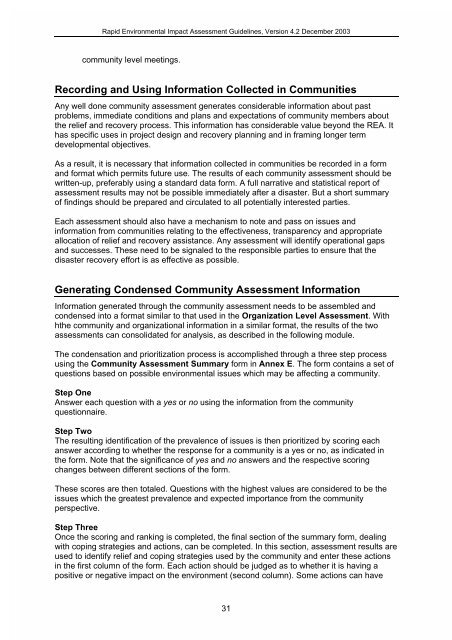Guidelines for Rapid Environmental Impact Assessment in Disasters
Guidelines for Rapid Environmental Impact Assessment in Disasters
Guidelines for Rapid Environmental Impact Assessment in Disasters
You also want an ePaper? Increase the reach of your titles
YUMPU automatically turns print PDFs into web optimized ePapers that Google loves.
<strong>Rapid</strong> <strong>Environmental</strong> <strong>Impact</strong> <strong>Assessment</strong> <strong>Guidel<strong>in</strong>es</strong>, Version 4.2 December 2003<br />
community level meet<strong>in</strong>gs.<br />
Record<strong>in</strong>g and Us<strong>in</strong>g In<strong>for</strong>mation Collected <strong>in</strong> Communities<br />
Any well done community assessment generates considerable <strong>in</strong><strong>for</strong>mation about past<br />
problems, immediate conditions and plans and expectations of community members about<br />
the relief and recovery process. This <strong>in</strong><strong>for</strong>mation has considerable value beyond the REA. It<br />
has specific uses <strong>in</strong> project design and recovery plann<strong>in</strong>g and <strong>in</strong> fram<strong>in</strong>g longer term<br />
developmental objectives.<br />
As a result, it is necessary that <strong>in</strong><strong>for</strong>mation collected <strong>in</strong> communities be recorded <strong>in</strong> a <strong>for</strong>m<br />
and <strong>for</strong>mat which permits future use. The results of each community assessment should be<br />
written-up, preferably us<strong>in</strong>g a standard data <strong>for</strong>m. A full narrative and statistical report of<br />
assessment results may not be possible immediately after a disaster. But a short summary<br />
of f<strong>in</strong>d<strong>in</strong>gs should be prepared and circulated to all potentially <strong>in</strong>terested parties.<br />
Each assessment should also have a mechanism to note and pass on issues and<br />
<strong>in</strong><strong>for</strong>mation from communities relat<strong>in</strong>g to the effectiveness, transparency and appropriate<br />
allocation of relief and recovery assistance. Any assessment will identify operational gaps<br />
and successes. These need to be signaled to the responsible parties to ensure that the<br />
disaster recovery ef<strong>for</strong>t is as effective as possible.<br />
Generat<strong>in</strong>g Condensed Community <strong>Assessment</strong> In<strong>for</strong>mation<br />
In<strong>for</strong>mation generated through the community assessment needs to be assembled and<br />
condensed <strong>in</strong>to a <strong>for</strong>mat similar to that used <strong>in</strong> the Organization Level <strong>Assessment</strong>. With<br />
hthe community and organizational <strong>in</strong><strong>for</strong>mation <strong>in</strong> a similar <strong>for</strong>mat, the results of the two<br />
assessments can consolidated <strong>for</strong> analysis, as described <strong>in</strong> the follow<strong>in</strong>g module.<br />
The condensation and prioritization process is accomplished through a three step process<br />
us<strong>in</strong>g the Community <strong>Assessment</strong> Summary <strong>for</strong>m <strong>in</strong> Annex E. The <strong>for</strong>m conta<strong>in</strong>s a set of<br />
questions based on possible environmental issues which may be affect<strong>in</strong>g a community.<br />
Step One<br />
Answer each question with a yes or no us<strong>in</strong>g the <strong>in</strong><strong>for</strong>mation from the community<br />
questionnaire.<br />
Step Two<br />
The result<strong>in</strong>g identification of the prevalence of issues is then prioritized by scor<strong>in</strong>g each<br />
answer accord<strong>in</strong>g to whether the response <strong>for</strong> a community is a yes or no, as <strong>in</strong>dicated <strong>in</strong><br />
the <strong>for</strong>m. Note that the significance of yes and no answers and the respective scor<strong>in</strong>g<br />
changes between different sections of the <strong>for</strong>m.<br />
These scores are then totaled. Questions with the highest values are considered to be the<br />
issues which the greatest prevalence and expected importance from the community<br />
perspective.<br />
Step Three<br />
Once the scor<strong>in</strong>g and rank<strong>in</strong>g is completed, the f<strong>in</strong>al section of the summary <strong>for</strong>m, deal<strong>in</strong>g<br />
with cop<strong>in</strong>g strategies and actions, can be completed. In this section, assessment results are<br />
used to identify relief and cop<strong>in</strong>g strategies used by the community and enter these actions<br />
<strong>in</strong> the first column of the <strong>for</strong>m. Each action should be judged as to whether it is hav<strong>in</strong>g a<br />
positive or negative impact on the environment (second column). Some actions can have<br />
31
















